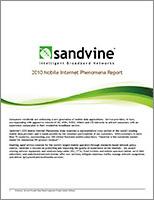I was about to file Sandvine’s latest report “Mobile Networks Mimic Fixed Line ” under the stating the obvious section of the site, aka the trash. But I thought better of it as unbelievably there are people out there who think that mobile networks are a law unto themselves, and who for some reason think that if you give someone a big fat pipe, and a whole world of content, then the last thing they’ll do is smoke it.
Sandvine’s Internet traffic trends report “Mobile Internet Phenomena” looks at the state of mobile networks and analyses traffic trends on a representative cross-section of the world’s leading mobile data providers and not unexpectedly they found that mobile broadband users behave in the same way as desktop broadband users.
Here’s just a few key observations from the Mobile Internet Phenomena report:
- Globally, the top five percent of subscribers account for 50 percent of network traffic.
- Social networking accounts for up to nine percent of total bytes on any given mobile network
- Roughly one in five mobile data subscribers regularly use Facebook
- YouTube accounts for 10 to 15 percent of total bytes on a given mobile network
- Almost 30 percent of mobile subscribers in Caribbean and Latin America use Facebook in any given hour – the highest percentage of any other region
- Mobile traffic is becoming similar to fixed line traffic as laptops dominate the airwaves
“In our Mobile Internet report, we observed that mobile users were running similar applications as on fixed networks, including real-time communications such as IM and Skype,” said Dave Caputo, President and CEO, Sandvine. “With the emergence of more powerful mobile devices, like the iPad, and the ready availability of laptop dongles, more and more users on the go will be foregoing traditional voice in favour of data-centric, bandwidth-intensive applications.”
Voice is consuming an ever smaller percentage of overall mobile network traffic. According to a March report by analyst Chetan Sharma, a member of the GigaOM Pro Analyst Network, U.S. data traffic exceeded voice traffic by almost 400,000 GB in 2009 and that ratio is expected to double this year.
“Mobile data has definitely become a mainstream phenomenon as subscribers are increasingly relying on their mobile connection to do the things their home PC can,” said Mr. Caputo. “As more and more applications are offered on mobile devices, operators are looking to predict usage patterns to offer personalized service tiers that increase customer satisfaction, and to build out their networks to match user demand. An understanding of current usage patterns is a critical first step towards those goals.”
However while we agree with the findings, what we don’t agree with is Sandvine’s frankly ludicrous advice to the network operators about how to mitigate their data problem.
“A challenge facing mobile operators worldwide is educating subscribers on application and byte usage,” said Mr. Caputo. “Most usage-based billing plans are purely speed or byte-driven, rather than event-driven. With Sandvine’s solutions, service providers can develop service tiers that are easily digestible such as 70 YouTube hours per month rather than 6 Mbps download speed or 25 GB of data per month. This helps subscribers quantify their usage and continue using the applications and service they love.”
Sandvine predicts that service tiers and plans will evolve to empower subscribers to design their own personalized plans based on their specific preferences and usage allowances using a design my plan function.
Nice idea. But it’s just not going to work. Imagine trying to do the same thing on desktop broadband. Sorry honey you’re going to have to stop watching Sex in the City on catch up as we’re about to go over our bandwidth allocation. It’s just not going to happen. Nobody is going to clock watch on a mobile, even if you substitute a sensible metric like hours of videos instead of gigabytes, the download, download, download attitude is too hardwired in our brains after years of broadband use.
Read and exec summary of the 2010 Mobile Internet Phenomena report at www.sandvine.com/news/global_broadband_trends.asp or fill in the form and get the full report
